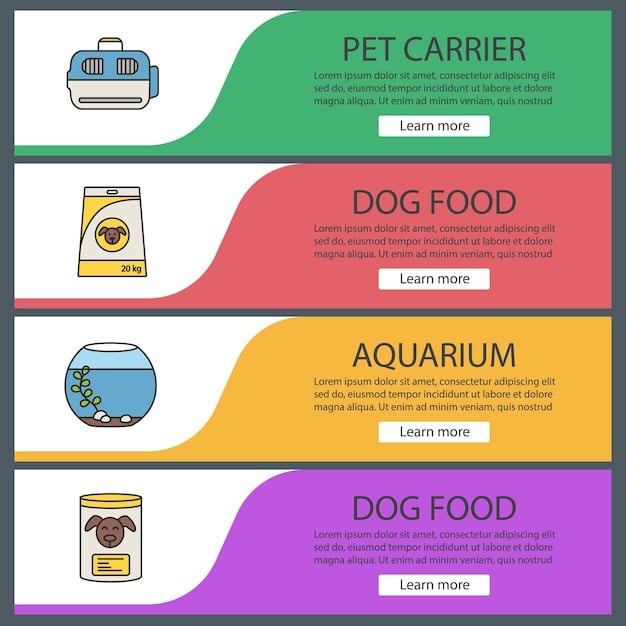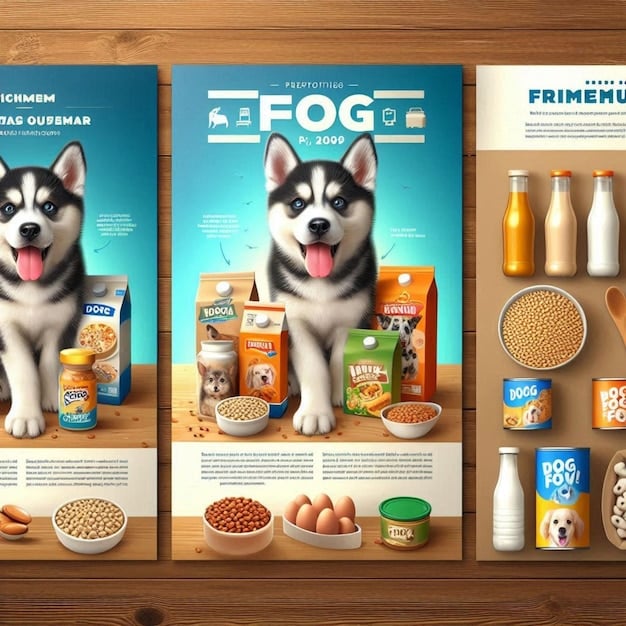Decoding Dog Food Labels: Your 2025 Guide to Informed Choices

Decoding Dog Food Labels: A 2025 Guide to Ingredient Analysis and Brand Reviews equips pet owners with the knowledge to navigate the complexities of dog food labels, ensuring informed decisions for their canine companions’ health and well-being through detailed ingredient analysis and brand assessments.
Navigating the world of dog food can feel like deciphering a secret code. This comprehensive guide, decoding dog food labels: a 2025 guide to ingredient analysis and brand reviews, aims to empower you with the knowledge to choose the best food for your furry friend, ensuring a happy and healthy life.
Understanding the Basics of Dog Food Labels
Dog food labels are more than just a list of ingredients; they are a window into the quality and nutritional value of the food. Learning to interpret these labels is the first step in making informed decisions about your dog’s diet.
Key Components of a Dog Food Label
Understanding the different sections of a dog food label can help you quickly assess the product’s quality. Here’s a breakdown of the essential elements:
- Product Name: Indicates the main ingredients and their percentage.
- Guaranteed Analysis: Shows the minimum percentages of crude protein and fat, and the maximum percentages of crude fiber and moisture.
- Ingredient List: Lists all ingredients in descending order by weight.
- Nutritional Adequacy Statement: Confirms that the food meets the nutritional levels established by AAFCO (Association of American Feed Control Officials).
Each of these components plays a crucial role in determining the suitability of the food for your dog. Pay close attention to the ingredient list and nutritional adequacy statement.

Deciphering Ingredient Lists: What to Look For
The ingredient list is perhaps the most important part of a dog food label. It tells you exactly what’s in the food, and in what order of prevalence.
Prioritizing Whole Foods
Look for whole, recognizable foods at the top of the list. These include named meats (e.g., chicken, beef, lamb), whole grains (e.g., brown rice, oatmeal), and vegetables (e.g., carrots, sweet potatoes). Quality dog foods prioritize these over processed ingredients.
Ingredients to Avoid
Certain ingredients are best avoided due to their potential negative impact on your dog’s health. These include:
- Generic “Meat” or “Animal” By-Products: These can come from unspecified sources and may be of low quality.
- Artificial Colors, Flavors, and Preservatives: These offer no nutritional value and may cause allergic reactions in some dogs.
- Fillers like Corn, Wheat, and Soy: These are often used as inexpensive fillers and can be difficult for dogs to digest.
Being vigilant about these ingredients will help you select a healthier option for your dog.
Understanding the ingredient list is vital for ensuring your dog receives optimal nutrition.
Understanding Guaranteed Analysis and Nutritional Adequacy
The guaranteed analysis and nutritional adequacy statement are crucial for determining if a dog food meets your pet’s nutritional needs. These sections provide essential information about the food’s composition and whether it adheres to industry standards.
Interpreting Guaranteed Analysis
The guaranteed analysis lists the minimum percentage of crude protein and fat, and the maximum percentage of crude fiber and moisture. However, these values can be misleading without understanding how they are calculated.
- Crude Protein: While a higher percentage may seem better, the source of the protein is more important. Look for protein from named meat sources.
- Crude Fat: Essential for energy and absorption of certain vitamins. Again, the source is critical; look for healthy fats like fish oil or flaxseed.
- Crude Fiber: Important for digestive health. However, excessive fiber can decrease the digestibility of other nutrients.
Remember that the guaranteed analysis provides a general overview, and the quality of ingredients is just as important as the percentages listed.
Nutritional Adequacy Statement
The nutritional adequacy statement confirms that the food meets the nutritional levels established by AAFCO. This statement indicates whether the food is complete and balanced for a specific life stage (e.g., growth, maintenance, all life stages).
Ensuring that the dog food meets AAFCO standards provides assurance that it contains the necessary nutrients for your dog’s health.
Navigating Marketing Claims and Buzzwords
Dog food marketing can be misleading, with companies using buzzwords and claims to attract consumers. It’s important to look beyond the hype and understand what these claims truly mean.

Decoding Common Marketing Terms
Many marketing terms on dog food labels lack a strict legal definition, making them open to interpretation. Here are some common terms and what they typically imply:
- “Natural”: Generally means that the ingredients are derived from plant, animal, or mineral sources, but it doesn’t necessarily mean the food is healthier.
- “Grain-Free”: Indicates the absence of common grains like corn, wheat, and soy, but may contain other carbohydrates like potatoes or peas.
- “Limited Ingredient Diet”: Contains a minimal number of ingredients, which can be beneficial for dogs with sensitivities or allergies.
Looking Beyond the Hype
Always scrutinize the ingredient list and guaranteed analysis, regardless of the marketing claims. Focus on the quality and source of ingredients rather than relying solely on buzzwords.
By being informed and skeptical, you can make better choices for your dog’s nutrition.
Comparing Dog Food Brands: A 2025 Perspective
With so many dog food brands on the market, it can be overwhelming to choose the right one. In 2025, consumers are increasingly seeking transparency, sustainability, and scientifically-backed nutrition.
Evaluating Brand Reputation
Researching a brand’s reputation is crucial. Look for brands with a long history of quality and a commitment to animal welfare. Check for independent reviews and recalls.
Considering Nutritional Philosophy
Different brands have different nutritional philosophies. Some prioritize high protein, while others focus on balanced nutrition for all life stages. Choose a brand whose philosophy aligns with your dog’s specific needs.
The Rise of Personalized Nutrition
In 2025, personalized dog food is becoming increasingly popular. These services tailor meals to your dog’s individual needs based on factors like age, breed, activity level, and health conditions.
Keeping these factors in mind will help you navigate the crowded dog food market and find the best option for your furry friend.
Transitioning to a New Food: A Step-by-Step Guide
Changing your dog’s food should be a gradual process to avoid digestive upset. A slow transition allows your dog’s digestive system to adjust to the new ingredients.
Gradual Introduction
Start by mixing a small amount of the new food with your dog’s current food. Gradually increase the proportion of the new food over 7-10 days.
If your dog experiences digestive issues like diarrhea or vomiting, slow down the transition or consult your veterinarian.
Monitoring Your Dog’s Response
Pay close attention to your dog’s stool consistency, energy levels, and overall health during the transition. These observations will help you determine if the new food is a good fit.
A careful and gradual transition ensures a smooth and healthy change in diet for your canine companion.
| Key Point | Brief Description |
|---|---|
| 🔍 Ingredient List | Prioritize whole foods and avoid by-products, artificial additives, and fillers. |
| 📊 Guaranteed Analysis | Understand protein, fat, and fiber percentages, but focus on ingredient quality. |
| ✅ Nutritional Adequacy | Ensure the food meets AAFCO standards for complete and balanced nutrition. |
| 🌱 Marketing Claims | Look beyond buzzwords; scrutinize ingredients over marketing terms. |
Frequently Asked Questions
▼
“Crude protein” refers to the total protein content in the food, but it doesn’t indicate the quality of the protein. Ensure the protein comes from high-quality, named meat sources.
▼
Not necessarily. While some dogs may benefit from grain-free diets, they aren’t inherently superior. Ensure the food provides balanced nutrition, regardless of grain content.
▼
Check for the AAFCO (Association of American Feed Control Officials) statement on the label. This confirms that the food meets nutritional standards for a specific life stage.
▼
Ingredients are listed in descending order by weight. The first few ingredients make up the bulk of the food, so they should be high-quality and nutritious.
▼
Avoid foods with generic “meat” or “animal” by-products, artificial additives, and excessive fillers like corn, wheat, and soy. These can indicate lower quality.
Conclusion
Decoding dog food labels empowers you to make informed choices for your canine companion’s health. By understanding the ingredients, guaranteed analysis, and marketing claims, you can navigate the complexities of the dog food market and select a food that meets your dog’s specific nutritional needs.





